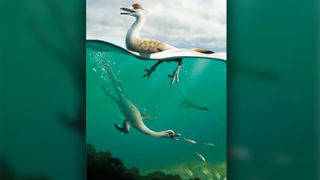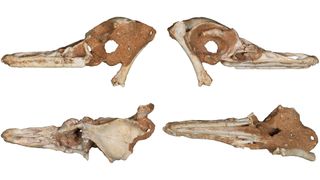Noodle-necked swimming dinosaur may have been a diving predator like a penguin
Scientists recently discovered the first non-avian theropod dinosaur with a streamlined body similar to that of penguins, auks and other modern diving birds.

A dinosaur with an undulating noodle neck and a streamlined body like those of modern diving birds may have plunged through the depths of a Cretaceous sea about 71 million to 72 million years ago, in what is now Mongolia. This predator belonged to a different lineage of theropods — bipedal and mostly meat-eating dinosaurs — than the one that produced modern birds, but its body shape and limbs hint that it swam and dove as a penguin does, scientists recently discovered.
The skeleton was in exceptional condition with a near-complete skull. It was excavated from the Baruungoyot (also spelled Barun Goyot) Formation, a location in the southern part of Mongolia's Gobi Desert dating to the Cretaceous period (145 million to 66 million years ago). In life, it would have been about the size of a mallard duck, and researchers noted that its gooselike neck, flipperlike forelimbs and proportions of its digits resembled those of the Mongolian theropod genus Halszkaraptor, which is thought to be aquatic.
However, there isn't enough fossil evidence from Halszkaraptor and its closest relatives to suggest what their body shapes may have looked like.
The newfound fossil is more complete than any of the known Halszkaraptor fossils; the skeleton is "mostly articulated" with ribs that are oriented toward the tail, as they are in aquatic diving birds, according to a study published Dec. 1 in the journal Communications Biology. This offered scientists the first evidence of a nonavian theropod with a body that was optimized for reducing drag in aquatic environments.
Related: 'Dwarf dinosaur' that lived on prehistoric island unearthed in Transylvania
These adaptations, along with teeth that were "unusually numerous" and "tightly packed" in the jaw, would have made the diving dinosaur a fearsome aquatic predator, and the number and shape of its teeth suggests that it hunted for fish or insects, according to the study. Researchers named the newly described genus and species Natovenator polydontus; the genus comes from the Latin words for "swim" ("nato") and "hunter" ("venator"), while the species means "many teeth" in Greek.
"The long nares [nostrils] and posterior rib orientation are only known in Natovenator because these parts are not well preserved in Halszkaraptor," said study co-author Yuong-Nam Lee, a professor of vertebrate paleontology in the School of Earth and Environmental Sciences at Seoul National University in South Korea.
Sign up for the Live Science daily newsletter now
Get the world’s most fascinating discoveries delivered straight to your inbox.
N. polydontus probably wasn't able to soar through the air with its short, flattened forelimbs, though it may have used them to paddle through water. But one of the most compelling clues about its aquatic habits was its ribs — specifically, the direction in which they were pointing. In land-based theropods, the dorsal ribs extended from the spine in a mostly horizontal arc. But in N. polydontus, these ribs curved back toward its tail. Such backward-oriented ribs lower the height of the rib cage, and are a feature in diving birds, Lee told Live Science in an email. This suggests that N. polydontus had a streamlined body, "which would be advantageous because a streamlined body reduces drag in the water and allows efficient swimming," Lee said.

Ever since the first vertebrates crawled out of the oceans to live on land, "many different groups have secondarily adapted to aquatic environments," the scientists wrote in the study. Whales, for example, evolved from four-legged terrestrial mammals before adapting to live exclusively in the oceans. Among dinosaurs, only birds and some of their extinct ancestors evolved aquatic or semi-aquatic forms. (A bizarre sail-backed dinosaur called Spinosaurus was briefly hailed as a "swimming dinosaur", but the claim is controversial among paleontologists, and a 2021 study in the journal Palaeontologia Electronica proposed that Spinosaurus would have been a mediocre swimmer at best.)
However, N. polydontus looks like it would have been right at home in the ocean's depths.
"Natovenator is a valuable discovery to awaken how diverse dinosaurs' ecological position was," Lee said. "Finding semi-aquatic dinosaurs means that the ecological diversity was very high in dinosaurs, and it could change our prejudice about the lifestyle of dinosaurs. More than 30 different lineages of tetrapods have independently invaded water ecosystems. Why not dinosaurs?"

Mindy Weisberger is an editor at Scholastic and a former Live Science channel editor and senior writer. She has reported on general science, covering climate change, paleontology, biology, and space. Mindy studied film at Columbia University; prior to Live Science she produced, wrote and directed media for the American Museum of Natural History in New York City. Her videos about dinosaurs, astrophysics, biodiversity and evolution appear in museums and science centers worldwide, earning awards such as the CINE Golden Eagle and the Communicator Award of Excellence. Her writing has also appeared in Scientific American, The Washington Post and How It Works Magazine.
